Download
in PDF Format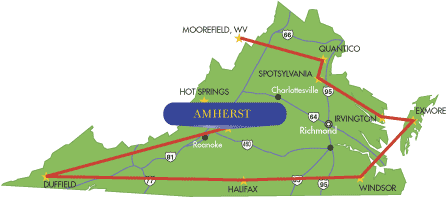
Home to highly esteemed sweet
briar college and Virginia�s oldest main street roundabout.
Among the town of
Amherst�s myriad blessings are its people, its extraordinary natural
surroundings and its proximity to other attractive places.
It is the Amherst
County
seat, but that wasn�t the case when the county was established in 1781.
Then, the courthouse was about 20 miles north, in what became Nelson
County
when the two split in 1807. A stage stop between Charlottesville
and Lynchburg
called The Oaks or Seven Oaks was chosen to be the new government center
and was renamed Amherst Courthouse.
|
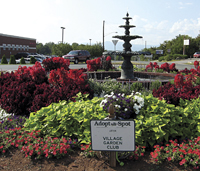
Amherst's
historic traffic circle was originally built in 1936 and was
redesigned as a roundabout around 1940. |
In the 18th and 19th centuries,
courthouses were commercial hubs, so the town also has enjoyed a steady
economy. In time, a mix of manufacturing companies and nearby Sweet
Briar
College
added to its fortunes.
Maybe � in light of the stories
I.
Paul Wailes III heard as a child � providence smiled on the village
of
Amherst Court�house
when it cleaned up its act in 1910. His mother told him how the town
incorporated that year in part so it could establish a police force.
The trouble arose from a glut of
drinking establishments, says Wailes, 78. It was especially rough on court
days when crowds came in from the country to shop and take care of legal
affairs.
�It was so horrible at the turn of
the century that the wives of all the attorneys accompanied their husbands
to court for fear of what might happen,� notes Wailes, whose grandfather
was a lawyer. �And they went armed.�
|

The
Florence Elston Inn & Conference Center at Sweetbriar College
offers lodging and catering, plus access to the 3,250-acre campus. |
It�s even possible the state�s
prohibition movement gained steam in Amherst in 1902, after a local judge, C.F. Campbell, horsewhipped the Rev. C.H.
Crawford.
According to authors C. C. Pearson and
J. Edwin Hendricks in their book, Liquor and Anti-Liquor in Virginia, 1619-1919, Crawford was the superintendent of the Virginia Anti-Saloon
League. He wrote an article in the League�s newspaper castigating the
judge�s handling of a trial in which a druggist was accused of selling
illegal quantities of liquor. Campbell
had given jury instructions that would ensure a finding of innocence.
|

After
the original courthouse was torn down in 1872, this section of the
present courthouse was built from "homemade brick of Amherst
County clay." |
In response to the public criticism,
the judge tried to convict Crawford of contempt. Failing, he settled for
beating the reverend and was impeached for his trouble. Crawford used the
affair to show the corruption of the �wets� in his own pursuit of a
dry state.
Today a drink may be had at a few
places, including the Briar Patch restaurant, serving the community since
1948, and Travelers Fine Food & Drink on the corner of Second and Main. By all accounts, though, little disturbs the peace in
Amherst.
Downtown doesn�t bustle as it did
when half a dozen family grocers, Wailes clothing store and the
five-and-dime operated a short distance from each other. But you can still
enjoy a pleasant lunch and shopping without getting back in your car.
�Within walking distance there are
four antique stores,� says Sharon Turner, manager of Hill House
Interiors. �Downtown is very inviting. It has a down-home feel.�
Flowers help make it inviting. The
Village Garden Club members put them everywhere, tucking perennials on a
busy corner and maintaining mixed gardens and planters around town.
Led by club president Carol Dziak and
her sister Pat DeLeon, they also installed a fountain in the historic
traffic circle where U.S. 60 and U.S. 29 Business intersect. They
landscaped around the fountain with seasonally rotated annual plants.
|

The
Amherst County High School Lancers won the group AA, Division 4
championship in 2006. |
Technically, �the �circle� today
operates like a true modern roundabout,� says Walter Pribble of the
Virginia Department of Transportation. Around 1940, the safer roundabout
design replaced the original 1936 circle, he says. It is the oldest
roundabout in the state.
The people of Amherst
have always been proud of the circle and they�re even more so now.
Dziak�s display of red, white and blue summer annuals drew raves,
especially for the tall, showy red Amaranthus. When she�s watering and
weeding, drivers honk and yell, �It�s looking beautiful, ladies,�
she says.
Old family businesses on
Main Street
� thriving near newer antique and gift shops, restaurants, realtors and
insurance agents � account for much of the down-home quality.
The Turner family has operated Hill
Hardware, established around 1914, since the 1930s. They opened Hill
House, a gift and furniture store, in 1987. W.A. Ogden runs Burch and Ogden, the appliance and furniture store his father and business partner Yale
Burch started after World War II.
Ogden
likes the quiet. He chuckled when thinking of the days before the U.S. 29
bypass was completed in the early 1970s. �I wonder how we made it in
town with all that traffic coming through here,� he says, joking that it
could be hazardous to step off the curb.
Strip development did not spring up on
the bypass near Amherst, which is about 15 miles north of
Lynchburg
, but it was rampant in Madison Heights
to the south. A new bypass from the entrance of
Sweet
Briar
College
to U.S. 460 near the Lynchburg
airport opened in 2005.
Town leaders believe what the old
bypass took away, the new one can give back.
|
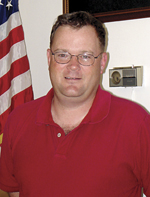
Jack
Hobbs has served Amherst as town manager since 1992. |
�The current theory is that with the
bypass bringing traffic and because it is the [government] center, we
ought to roll with that,� says town manager Jack Hobbs.
The town has implemented several
initiatives, including funding some of the garden club�s beautification
efforts. It invested in municipal wireless Internet access and
commissioned a study to recommend revitalization options.
For the past two summers, merchants,
residents, civic groups and local government sponsored several Amherst
LIVE! events featuring live music, children�s activities, arts and
crafts, and beer and wine sales. Turnout has been good for the evening
street festivals.
Wailes, who embraced the first bypass,
also believes the new one represents progress. �I don�t think progress
has a negative impact on anything,� he says.
He is part owner of
Ambriar
Plaza
, which is adjacent to U.S.
29 and the first thing drivers see coming from the bypass. He built it in
1973 with partners Thomas Howell and Rex Pixley. He remains partners with
his associates� widows, Robbie Howell and Kathryn Pixley, and together
they are remodeling the shopping center.
|
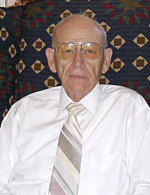
Paul
Wailes III, 78, is acknowledged as Amherst's unofficial
historian. |
�We want it to look nice and I want
to do it before I go,� Wailes says.
The new road also fuels Hobbs� vision of
Amherst as a base camp for tourism. �You could day trip to the Appomattox
surrender grounds, Poplar Grove [Golf Club], Virginia Military Institute,
Charlottesville and Monticello, and the D-Day Memorial in Bedford,� he
says, naming a few of the attractions in a 360-degree radius.
�Nothing�s more than an hour away.�
For those who do visit, Charles Hamble,
a volunteer at the Amherst County Historical Society, also recommends
seeing the nearby Monacan Indian Museum and, of course, the Blue Ridge
Parkway. �It�s always there, no matter what the season. It�s always
beautiful and always changing,� he says.
Traveling west, U.S. 60 climbs the
eastern slope of the
Blue Ridge Mountains
for 22 miles, intersecting the parkway at the county line. Along the way
is access to the Appalachian Trial, including the Mount Pleasant Scenic
Area where hiking trails reach elevations up to 4,000 feet, and the
Pedlar
River.
|

The
Pedlar River |
The Pedlar, �if you don�t want to
do anything at all,� says Bill Wydner, �is a good place to put your
feet.�
Wydner, 68, is worth visiting, too. He
manages the Amherst Milling Co., a grist mill on Rutledge Creek that still
uses a water wheel. His father bought the mill and feed store in 1940,
when it was already more than 100 years old.
All day long customers crowd into the
tiny air-conditioned office, forming a line outside if necessary. Inside,
like strata marking the passage of time, ancient photographs, receipts,
advertising placards � even a stock certificate from the defunct Amherst
Power and Light Co. � plaster every inch of wall.
On the mill floor, machinery reaches
up three stories. Wydner doesn�t do tours, but he�s an engaging host
as he points out the elevators, gears and belts going every which way.
|
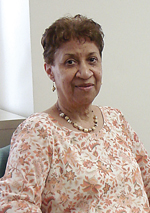
Gloria
Higginbotham, a life-long Amherst resident, used to teach in local
public schools. |
�My grandfather used to take his
corn down there for him to grind,� says Gloria Higginbotham, who was
baptized in the creek near the mill in 1948. �That was kind of the hub
for the farmers.�
These days she stops in occasionally
for the produce Wydner buys from local growers.
Despite Wydner�s merry-eyed grousing
that, �if it wasn�t for pop-in and pop-out microwaves, we�d all
starve to death,� people still buy his rye and whole-wheat flour, corn
meal and pancake mix. He also grinds assorted animal feeds, fine forms of
which dust his navy blue work pants and shirt.
Wydner, and many of his patrons,
embody something else Paul Wailes heard about
Amherst
when he was young: �Anybody who ever got this red mud of
Amherst
County
on their feet will never shake it.�